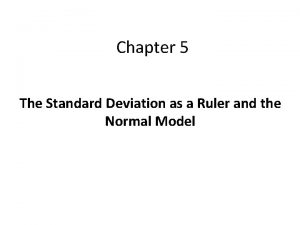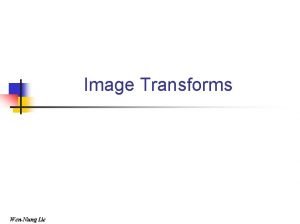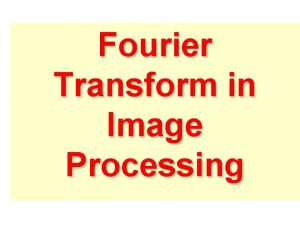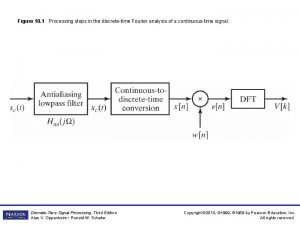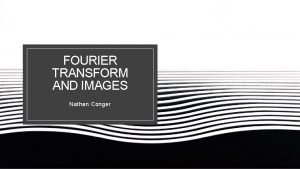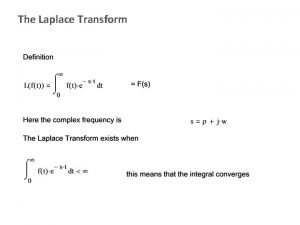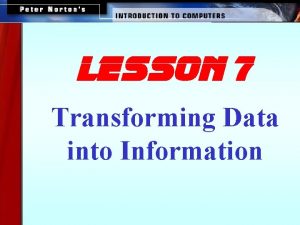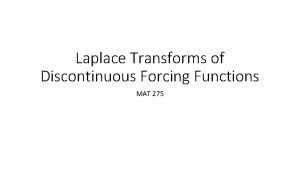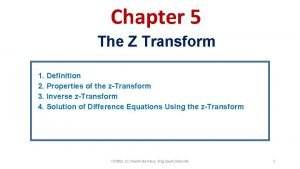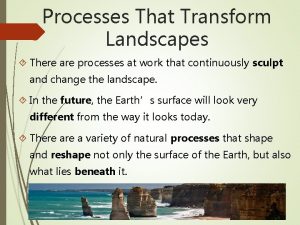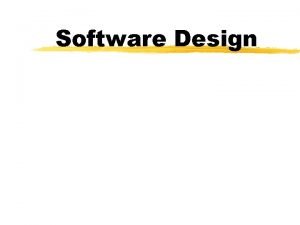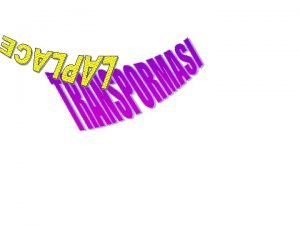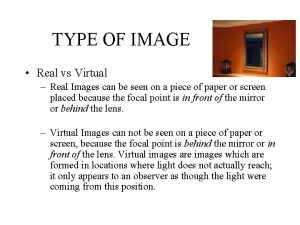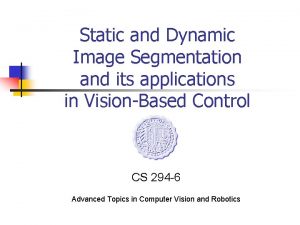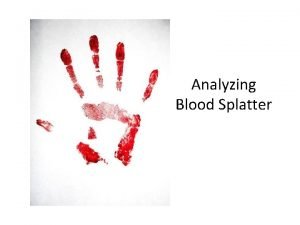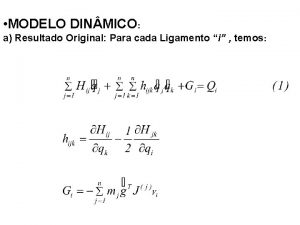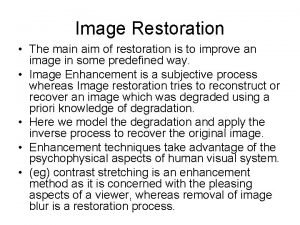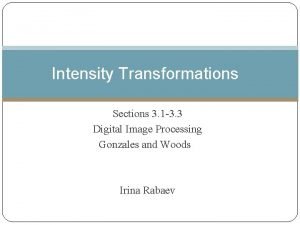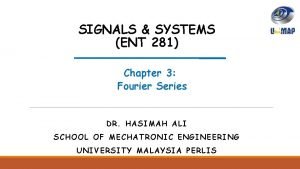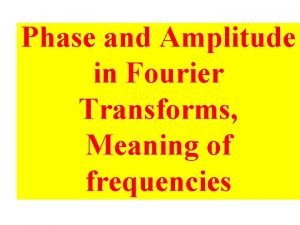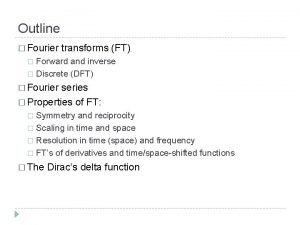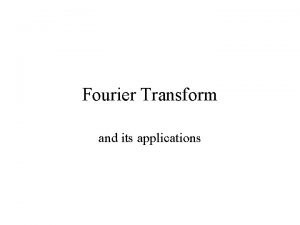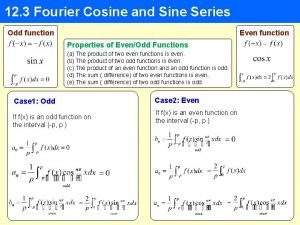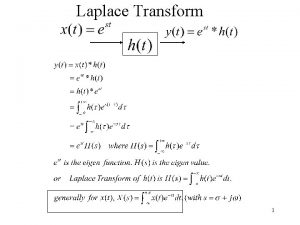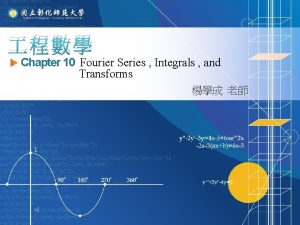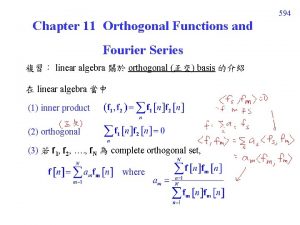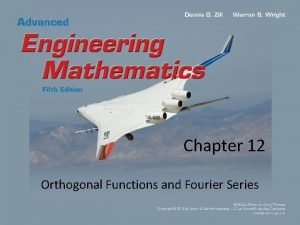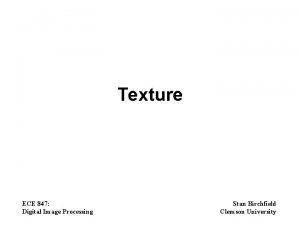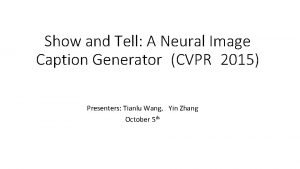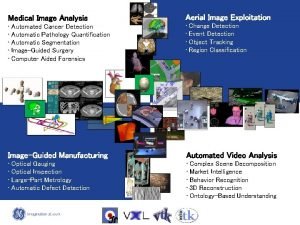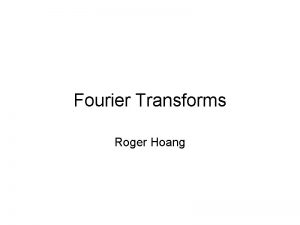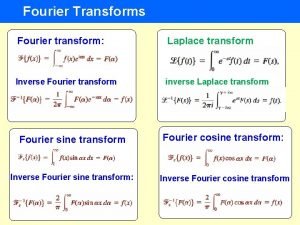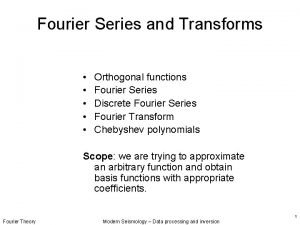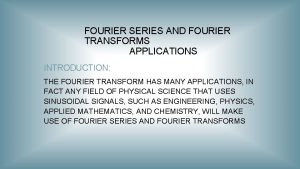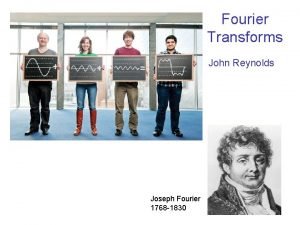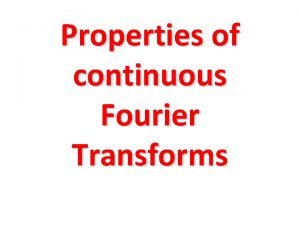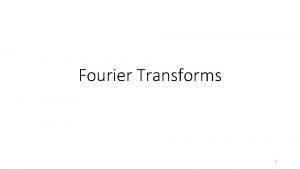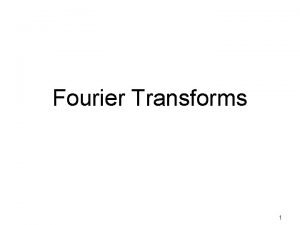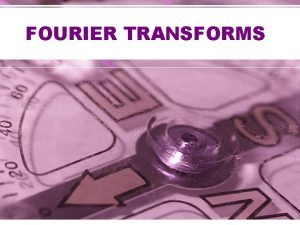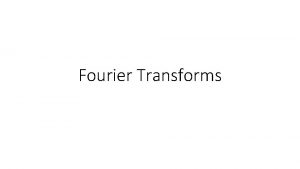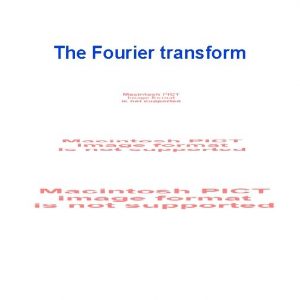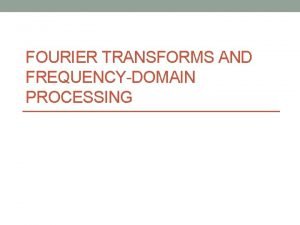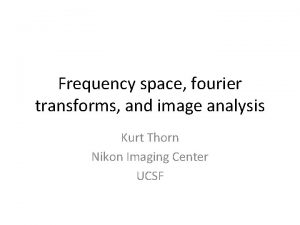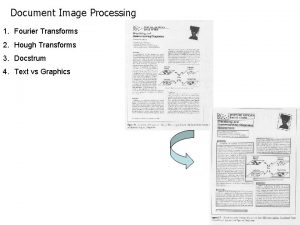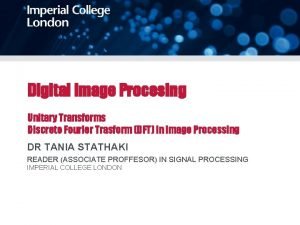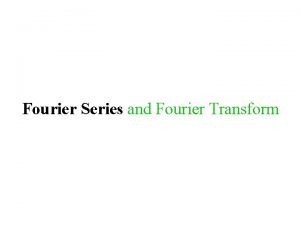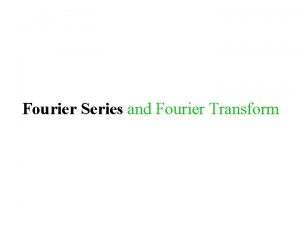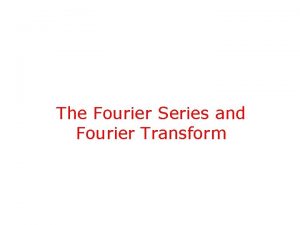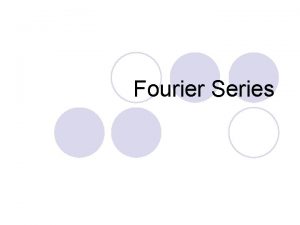Fourier transforms and rescaling Fourier transforms Image Fourier
















































![Gaussian pyramids [Burt and Adelson, 1983] • In computer graphics, a mip map [Williams, Gaussian pyramids [Burt and Adelson, 1983] • In computer graphics, a mip map [Williams,](https://slidetodoc.com/presentation_image_h2/bcd6b23fee9ab1bb292d8b62d67847cd/image-49.jpg)









- Slides: 58

Fourier transforms and rescaling

Fourier transforms Image Fourier transform

Low-pass filtering * Fourier * = =

High-pass filtering - =

Band-pass filtering - = - =

Hybrid images (PA 1)

Hybrid images (PA 1)

Hybrid images (PA 1)

Resizing and resampling

Let’s enhance! Louis Daguerre, 1838

Let’s enhance! • When is enhancement possible? • How can we model what happens when we upsample or downsample an image? • Resizing up or down very common operation • Searching across scales • applications have different memory/quality tradeoffs

What is a (digital) image? • True image is a function from R 2 to R • Digital image is a sample from it • 1 D example: • To enhance, we need to recover the original signal and sample again

Undersampling © Kavita Bala, Computer Science, Cornell University

Undersampling • What if we “missed” things between the samples? • Simple example: undersampling a sine wave • • unsurprising result: information is lost surprising result: indistinguishable from lower frequency also was always indistinguishable from higher frequencies aliasing: signals “traveling in disguise” as other frequencies

Aliasing • When sampling is not adequate, impossible to distinguish between low and high frequency signal © Kavita Bala, Computer Science, Cornell University

Aliasing in time

Aliasing in time

Image Scaling What happens if we naively upsample? Source: S. Seitz

Image sub-sampling 1/16 1/4 Throw away every other row and column to create a 1/2 size image - called image sub-sampling Source: S. Seitz

Image sub-sampling 1/2 1/4 (2 x zoom) 1/16 (4 x zoom) Why does this look so crufty? Aliasing! Source: S. Seitz

Image sub-sampling Source: F. Durand

Point sampling in action Cornell CS 4620 Fall 2015 • Lecture

How many samples do we need? • 1 sample per time period is too less:

How many samples do we need? • 2 samples per time-period is enough • Nyquist sampling theorem: Need to sample at least 2 times the frequency • General signals? Need to sample at least 2 times the maximum frequency

Nyquist sampling: why? Spatial domain Frequency domain

Nyquist sampling: why?

Nyquist sampling: why?

Aliasing and downsampling • Nyquist says must sample at at least twice maximum frequency • When downsampling by a factor of two • Original image has frequencies that are too high • How can we fix this? • Eliminate them before sampling! • Convert to frequency space • Multiply with low-pass filter

Eliminating High Frequencies © Kavita Bala, Computer Science, Cornell University

Process • Can we do this in spatial domain? • Yes! • Multiplication in frequency domain = convolution in spatial domain • Box filter in frequency domain = sinc in spatial domain • Multiplication with box filter in frequency domain = convolution with sinc filter in spatial domain

Reconstruction from samples Spatial domain Frequency domain

Reconstruction from samples Box filter in frequency space

Reconstruction from samples • Multiplication in frequency domain = convolution in spatial domain • Box filter in frequency domain = sinc filter in spatial domain • Convolve sampled signal with sinc filter to reconstruct

Reconstruction from samples • ”Sampled signal” is non-zero at sample points and 0 everywhere else • i. e. , has holes *

Recap: subsampling and reconstruction Subsampling Reconstruction 1. Convolve with sinc filter to eliminate high frequencies 2. Sample by picking only values at sample points 1. Start with sampled signal (0 at nonsample points) 2. Convolve with sinc to reconstruct

Sinc is annoying

Sinc and Gaussian • Sinc is annoying: infinite spatial extent • Use Gaussian instead! Sinc/box Gaussian Spatial domain Frequency domain

Subsampling images • Step 1: Convolve with Gaussian to eliminate high frequencies • Step 2: Drop unneeded pixels Subsampling without removing high frequencies Subsampling after removing high frequencies

Subsampling images correctly G 1/8 G 1/4 Gaussian 1/2 • Solution: filter the image, then subsample Source: S. Seitz

Subsampling with Gaussian pre-filtering Gaussian 1/2 G 1/4 G 1/8 • Solution: filter the image, then subsample Source: S. Seitz

Compare with. . . 1/2 1/4 (2 x zoom) 1/8 (4 x zoom) Source: S. Seitz

Upsampling images Step 1: blow up to original size with 0’s in between

Upsampling images Step 2: Convolve with Gaussian

Take-away • Subsampling causes aliasing • High frequencies masquerading as low frequencies • Remove low frequencies by blurring! • Ideal: sinc • Common: Gaussian • When upsampling, reconstruct missing values by convolution • Ideal: sinc • Common: Gaussian

So… can we enhance? • Nyquist theorem limits frequencies we can reconstruct from subsampled image • Can only reconstruct max sampling frequency/2 • Sorry CSI!

Pyramids

Gaussian pre -filtering • Solution: filter the image, then subsample F 0 blur subsample F 0 * H F 1 blur subsample F 1 * H F 2 …

{ Gaussian pyramid F 0 blur subsample F 0 * H F 1 blur subsample F 1 * H F 2 …
![Gaussian pyramids Burt and Adelson 1983 In computer graphics a mip map Williams Gaussian pyramids [Burt and Adelson, 1983] • In computer graphics, a mip map [Williams,](https://slidetodoc.com/presentation_image_h2/bcd6b23fee9ab1bb292d8b62d67847cd/image-49.jpg)
Gaussian pyramids [Burt and Adelson, 1983] • In computer graphics, a mip map [Williams, 1983] Gaussian Pyramids have all sorts of applications in computer vision Source: S. Seitz

Gaussian pyramids - Searching over scales

Gaussian pyramids - Searching over scales

The Gaussian Pyramid Low resolution sub-sample blur sub-samp le blur su subsam b- blur High resolution sa mp le ple

Gaussian pyramid and stack Source: Forsyth

Memory Usage • What is the size of the pyramid? 5 4

Laplacian pyramid Expand (up sample + b lur) -sam Expand (up sample + b l ur) ple + blur) Reduce Expand (up - = = = sample + b lur) =

Laplacian pyramid L 4 = G 4 = L 3 = G 3 - expand(G 4) = L 2 = G 2 - expand(G 3) = L 1 = G 1 - expand(G 2) = L 0 = G 0 - expand(G 1) =

Reconstructing the image from a Laplacian pyramid lur) + + + le + b samp p u ( d n a p x E = = blur) + e l p m a s d (up + blur) e l p m a s p Expand (u Expan = lur) le + b p m a s p u ( Expand + =

Laplacian pyramid Source: Forsyth
 Shifting and rescaling data worksheet
Shifting and rescaling data worksheet Walsh transform in digital image processing
Walsh transform in digital image processing Rescaling cos'è
Rescaling cos'è Image transforms
Image transforms Uu
Uu Analog image and digital image
Analog image and digital image Properties of fourier transform in digital image processing
Properties of fourier transform in digital image processing Fourier image processing
Fourier image processing Fourier
Fourier Eurylochus odyssey
Eurylochus odyssey Laplace transformation tabelle
Laplace transformation tabelle The unit that transforms data into information is the
The unit that transforms data into information is the Asu
Asu This transforms a bare stage into the world of the play
This transforms a bare stage into the world of the play Drama definition literature
Drama definition literature Inverse z-transform table
Inverse z-transform table Transforms eroded parts of earth's surface into lakes
Transforms eroded parts of earth's surface into lakes Friction transforms mechanical energy to
Friction transforms mechanical energy to Which phase transforms srs document into a form easily
Which phase transforms srs document into a form easily Piere simon
Piere simon Friction transforms mechanical energy to
Friction transforms mechanical energy to Inverse z transform table
Inverse z transform table Photosynthesis transforms light energy into chemical energy
Photosynthesis transforms light energy into chemical energy What are real and virtual image
What are real and virtual image Virtual vs real image
Virtual vs real image Image transform in digital image processing
Image transform in digital image processing Optimum notch filter in image processing
Optimum notch filter in image processing Spatial and temporal redundancy in digital image processing
Spatial and temporal redundancy in digital image processing Key stage in digital image processing
Key stage in digital image processing Fidelity criteria in digital image processing
Fidelity criteria in digital image processing Image sharpening and restoration
Image sharpening and restoration Static image vs dynamic image
Static image vs dynamic image Image geometry in digital image processing
Image geometry in digital image processing Area of convergence
Area of convergence The range of values spanned by the gray scale is called:
The range of values spanned by the gray scale is called: Appuyez sur l’image qui est dans le bon sens
Appuyez sur l’image qui est dans le bon sens Physical image vs logical image
Physical image vs logical image Qual o resultado de: imagem image
Qual o resultado de: imagem image Enlighten about image noise and restoration
Enlighten about image noise and restoration Maketform matlab
Maketform matlab Noise
Noise Xuite
Xuite Melody randford
Melody randford Power law transform
Power law transform Trigonometric and exponential fourier series
Trigonometric and exponential fourier series Phase invariance
Phase invariance Inverse discrete fourier transform
Inverse discrete fourier transform The fourier transform and its applications
The fourier transform and its applications Fourier sine and cosine series examples
Fourier sine and cosine series examples Relation between fourier and laplace transform
Relation between fourier and laplace transform Complex fourier series
Complex fourier series Fourier series linear algebra
Fourier series linear algebra Half range sine series
Half range sine series Fourier series and orthogonal functions
Fourier series and orthogonal functions Fourier transform formula
Fourier transform formula Show not tell generator
Show not tell generator Spiral progression in science
Spiral progression in science Image analysis and exploitation
Image analysis and exploitation Representation and description in digital image processing
Representation and description in digital image processing
